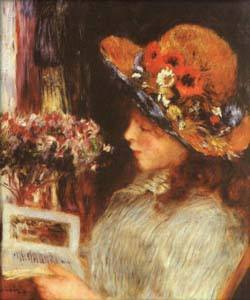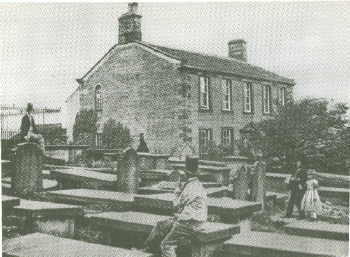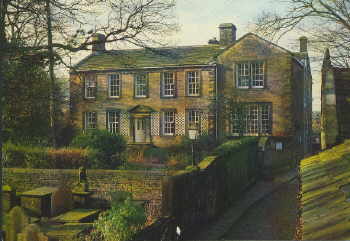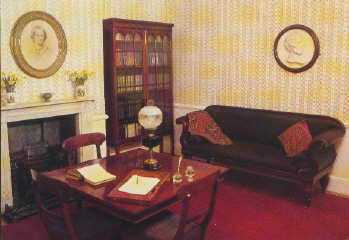
Charlotte Bronte was born Sunday, April 21, 1816 in Thornton, Yorkshire. She was the third daughter of Maria Branwell and the Reverend Patrick Bronte; Patrick was a Methodist clergyman. He was a well-read man who loved art, poetry, music. He was not a strict father, although he was almost wholly committed to religion. He could be short-tempered and difficult, but was also gregarious. He had married Maria when he was 35 and she was 30, a late marriage for both. He came from a peasant family and had been helped through Cambridge by patrons and very hard work. She was a member of a very old, modestly prosperous family, and was very intelligent and independent. She was also a pious and enthusiastic Methodist.
Their whirlwind courtship began in August 1812; they married in December 1812 and began having children immediately. The children were born 1 year apart: first Maria, then Elizabeth, then Charlotte, then Branwell, the only boy, then Emily, then Anne. So many births, so close together, were hard on Maria and her health was poor.
In January 1820, when Charlotte was 4, the family moved to Haworth, a town on the moors about 4 miles north of Thornton. It was bleak and remote, surrounded by mills and smoke.
Patrick Bronte believed in education, and all the children learned to read and write very early. Despite their limited means, he hired music and drawing tutors for them. Patrick also believed in the virtue of exercise, and forced the kids out onto the moors as soon as they could walk.
In January 1821, Maria fell ill, probably from a blood infection related to her last pregnancy. She died 8 agonizing months later, in September, and was buried in the crypt of the church, 30 yards from the house across the churchyard. Her sister, Elizabeth, came to help nurse her during her illness and stayed on to help with the children and the household after Maria's death.
The atmosphere was gloomier after that, quieter and more melancholy. Patrick withdrew from the children and isolated himself in the church or his study. Almost all of the children in Charlotte Bronte's stories and novels were orphans. Aunt Elizabeth was not frightening or hostile, like Mrs. Reed in Jane Eyre; she took care of the children, but without any particular affection. The oldest sister, Maria, became their surrogate mother. When their father paid any attention to them, he treated them as miniature adults: he discussed any topic with them; they helped him compose and proofread tracts, sermons, and poetry. They learned to value their own opinions and principles, and, being isolated socially, they learned to rely on each other for emotional and mental sustenance.
Their father, unable to educate all of his children properly by himself, decided to send them to school. On July 1, 1824, Maria and Elizabeth, the two oldest girls, left for Cowan Bridge School. Maria was 10 and Elizabeth was 9 at the time. On the 10th of August, Charlotte, then 8, joined them. In late November, 6-year-old Emily arrived.
The school appeared pleasant enough, and it had a good reputation, but this was deceptive. It was the model for Lowood School in Jane Eyre. School records show that the food was not sufficient: breakfast consisted of milk and 1 slice of dry bread, or porridge and milk. Dinner, at 1:00, was pudding (Yorkshire or rice), a small portion of meat, and vegetables. Tea, at 5:00, was the last meal: milk and 1 slice of dry bread. The school records also show that many students left because of "ill health," and there were several epidemics of typhus and typhoid fever. Charlotte wrote later, "Typhus fever decimated the school periodically, and consumption and scrofula in every variety of form, which bad air and water, and bad, insufficient diet can generate, preyed on the ill-fated pupils."
By the winter of 1824, Maria was seriously ill with consumption (tuberculosis); Helen Burns was modeled on Maria. Elixabeth's health was also deteriorating. By February 1825, Maria was too ill to stay at school and was sent home to Haworth. It was too late; she died May 6, 1825, at the age of 11. Elizabeth was left at school, getting paler and paler through the spring. She was sent home on May 31. She must have told her father what the school was really like, for the next day, he removed Charlotte and Emily from the school, too. Elizabeth died on June 15, two weeks later, at the age of 10.
At the age of 9, Charlotte was now the oldest, and the burden of being "mother" fell on her. The four remaining children, thrown together on their own, created their own world. For the next four years, they wrote daily stories chronicling events in "Glass Town," an imaginary country. They made up maps and a language for their country. And they did it all in miniature, in 2 1/4" X 1 1/4" booklets (these have been preserved at the library at the University of Texas at Austin, and can be read only with a magnifying glass). They also wrote dozens of plays and performed them. Charlotte, and later Emily and Anne, also began writing independent novellas and poetry. They were all completely contented with their lives.
This lasted until 1831, when Charlotte, 15, was sent to Roe Head School, to enable her to earn a living as a governess. Another girl she met there, Ellen Nussey, became one of her closest friends; Ellen's home, Rydings, was the inspiration for Thornfield, Rochester's house. Charlotte worked very hard at school, starting in the lowest class and working her way up to the highest and winning many of the school prizes. Her personality blossomed as well; she gained self-assurance and lost a lot of her shyness, but she stayed calm and dignified. She left Roe Head after 3 terms, in May 1832, and returned home.
Back at Haworth, life returned to its normal pattern. Charlotte and Branwell were very close. As the only boy, he had always been spoiled and at 14, he was beginning to be rebellious and arrogant. Emily and Anne spent all of their time together; they were even more isolated than Charlotte, and more caught up in their own imaginary world, Gondal.
In 1834, at age 17, Branwell was designated by Mr. Bronte for a career as an artist. He was clearly, with his impatience and quick temper, not suited for a career in the Church or at university. And he had begun to drink at the Black Bull Pub. There was not enough money to educate all of the children, so Branwell was given first priority in terms of his father's money and attention; the girls, feeling that they were the more talented and stable (which they were), were resentful, but were unable to change their father's mind. To help finance Branwell's tuition at the Royal Academy of Arts in London, Charlotte took a job teaching at Roe Head, which also offered a free place for one of her sisters. Emily went with her; they left on July 29, 1835.
She hated it. She did her job, but found it tiresome and monotonous. She had no time, freedom, or privacy for a life of the imagination. And she was more than homesick. Emily felt it more; her health declined. She was sent home after 3 months and Anne took her place, although she, too, was unhappy.
Branwell, meanwhile, was back at home after failing at the Academy: he had too little confidence and too much competition; too little ability and discipline, and too much drink. At home, he declared he'd be a great writer, but instead became obsessed with death and religious doubt.
Charlotte was in despair: she had taken the job only to pay for Branwell, and he'd failed and was wasting the family's money away. At home in 1836 for Christmas holidays, she desperately wrote to Robert Southey, the Poet Laureate of England, and sent him her work, asking if she should continue to write. He wrote her back in March 1837 and was not encouraging: there were too many poets now, he said, and besides, she was a woman:
Literature cannot be the business of a woman's life, and it ought not to be. The more she is engaged in her proper duties, the less leisure she will have for it, even as an accomplishment and a recreation. To those duties you have not yet been called, and when you are you will be less eager for celebrity...the daydreams in which you habitually indulge are likely to induce a distempered state of mind; and in proportion as all the ordinary uses of the world seem to you flat and unprofitable, you will be unfitted for them without becoming fitted for anything else.
He was certainly parroting the standard 19th century view of women, but, although his letter was a blow, Charlotte refused to be discouraged and kept writing and teaching. Finally, depressed, overworked, ill, and on the verge of a breakdown, she went home in June 1838. She recovered quickly.
Branwell was living in Bradford, trying to succeed as a portrait painter, but not making it. His friends had introduced him to opium, which was popular and legal then; at the time, it was cheaper than alcohol and not known to be addictive. But Branwell quickly became addicted; Charlotte was the first to notice its bad effects on him.
In the summer of 1839, Charlotte took her first job as a governess with the Sidgwick family, about 20 miles north of Haworth. They weren't bad people, but she still hated her job: she was not a servant, but not family, so she was isolated within the household. But it gave her material: John Reed was based on Benson Sidgwick, one of the children she cared for. The job ended in mid-July, 1839, and she went home and began writing to inquire about other jobs as a governess. She had another job for a while, but wasn't suited to being a governess.
In February 1842, with Emily, she went to Brussels, to the Pensionnat Heger, which was a teaching school run by Mr. and Mme. Heger; she and Emily hoped to learn enough to return home and begin their own school. Mr. Heger was young and dynamic, and Charlotte fell in love with him. She was 26 and he was 33, and they had a lot in common. But he was very married, and there was never an affair. Charlotte immortalized him in her novel Villette.
In October 1842, their Aunt Elizabeth died and they returned home. Branwell was now deeply depressed; he had been fired from a job after money went missing. He resolved to reform, but he was too weak. Charlotte, despite her worry about him, returned to Brussels to study, and Emily remained behind to run the house. Charlotte was happy in Brussels, but lonely without Emily. And Mme. Heger, uncomfortable about the attachment between Charlotte and her husband, isolated Charlotte more and more. Charlotte held out until December 1843, and then went home with her diploma and recommendation, planning to start a school with her sisters, Emily and Anne.
But her father was in bad health, and Branwell was always in trouble. And they couldn't attract enough students to get a school off the ground. Charlotte was miserable, and a friend of hers who was emigrating to Australia urged her to leave her family and start fresh in a new land. But Charlotte felt her duty was to stay with her family, who needed her--and she could never have been happy without them, anyway.
By now, Charlotte was 29; she was getting "old," and her firends teased her that she'd never get married. However, in May 1845, Mr. Bronte's new curate, Arthur Bell Nichols, arrived from Ireland. Her friends speculated that maybe he would be "the one," but Charlotte was not impressed by him.
By the summer of 1845, Branwell was home again, drinking constantly. Anne was writing Agnes Grey; Emily was starting Wuthering Heights; and Charlotte was running the house. Anne, Emily, and Charlotte were all writing poetry. In May 1846, at their own expense and under male pseudonyms, they published Poems by Currer, Ellis, and Acton Bell. The reviews were excellent, but few copies were sold. Once again, a financial investment had failed to pay off, and they were deeply worried about money. Emily submitted Wuthering Heights, Anne submitted Agnes Grey, and Charlotte submitted The Professor, but no publishers were interested.
In August 1846, Charlotte began writing Jane Eyre in a rooming house in Manchester, where her father was recovering from cataract surgery. She wrote in little square books, in pencil, holding the paper close to her eyes. She became obsessed with the story. By the end of September, Mr. Bronte was healed, his vision was restored, and they went home.
But Haworth was depressing. In December, Branwell was visited by a sheriff's officer, who threatened to jail him for debt. The sisters paid his debts, but that couldn't solve Branwell's problems. He was now too ill to get out of bed some days and go buy his own opium. In January, he set his bed on fire while smoking and was rescued by Emily.
In August 1847, Charlotte sent Jane Eyre to a publisher. It was published under the name Currer Bell in October 1847, and there was an immediate, enthusiastic response from the critics and the public: it sold well. George Henry Lewes wrote, "This, indeed, is a book after our own heart...no such book has gladdened our eyes for a long while. Almost all that we require in a novel she has: perception of character and power of delineating it; picturesqeness; passion; and knowledge of life...Reality--deep, significant reality--is the great characteristic of the book...it is soul speaking to soul..."
Only a few reviews attacked Jane Eyre for being "too daring" and "too unconventional"--but that was a few months later, after rumors had begun to circulate that the author was really a woman. Elizabeth Rigby, one of the most critical reviewers, called it an anti-Christian composition. She began by lamenting the novel's "coarseness of language and laxity of tone...It is a very remarkable book: we have no remembrance of another combining such genuine power with such horrid taste." But this is not her real quarrel with the novel; she objects far more to its implied religious and social messages:
It is true Jane does right, and exerts great moral strength, but it is the strength of a mere heathen mind which is a law unto itself. No Christian grace is perceptible upon her. She has inherited in fullest measure the worst sin of our fallen nature--the sin of pride. Jane Eyre is proud, and therefore she is ungrateful too. It pleased God to make her an orphan, friendless, penniless--yet she thanks nobody, and least of all Him, for the food and raiment, the friends, companions, and instructors of her helpless youth--for the care and education vouchsafed to her until she was capable in kind as fitted in years to provide for herself. On the contrary, she looks upon all that has been done for her as her undoubted right, but as falling far short of it. The doctrine of humility is not more foreign to her mind than it is repudiated by her heart. It is by her own talents, virtues, and courage that she is made to attain the summit of human happiness, and, as far as Jane Eyre's own statement is concerned, no one would think that she owed anything either to God above or to man below...Altogether the auto-biography of Jane Eyre is pre-eminently an anti-Christian composition. There is throughout it a murmuring against the comforts of the rich and against the privations of the poor, which, as far as each individual is concerned, is a murmuring against God's appointment--there is a proud and perpetual assertion of the rights of man, for which we find no authority either in God's word or in God's providence--there is that pervading tone of ungodly discontent which is at once the most prominent and the most subtle evil which the law and the pulpit, which all civilized society in fact has at the present day to contend with. We do not hesitate to say that the tone of mind and thought which has overthrown authority and violated every code human and divine abroad, and fostered Chartism and rebellion at home, is the same which has written Jane Eyre.
That December, Emily's Wuthering Heights and Anne's Agnes Grey were also published. And Charlotte finally broke the news to her father that she was a published author. She asked him to read her book, and he reluctantly consented. Later that day he rendered his verdict: at tea, he said, "Children, Charlotte has been writing a book--and I think it is a better one than I expected." That was all he had to say on the subject; the others never told him that they, too, had written books. Theirs were more daring and unconventional than Jane Eyre, and they were afraid of his reaction.
By 1848, Charlotte was working on Shirley, which was inspired by her sister Emily. She divided her time between writing and caring for Branwell, who by June was terribly ill. He had tuberculosis, but because of the symptoms of his addiction, they had not realized it for a long time. He was weak and emaciated, mostly bedridden. He died on September 24, 1848.
Charlotte collapsed: he had been her closest companion, and she grieved the waste of his life.
Tuberculosis is very contagious, and several weeks later, Emily fell ill, but refused to acknowledge it. She got weaker and weaker, and at 2 p.m. on December 19, 1848, she died on the sofa in the dining room.
Just two weeks after Emily's death, on January 5, 1849, a doctor confirmed that Anne, too, had tuberculosis. They tried every useless treatment that was then available, but she weakened steadily. She wanted to see the sea before she died, so in May they went to Scarbrough. She died there on Monday, May 28, 1849, and was buried there.
Now Charlotte was the only child left. She dreaded her solitary future. But Jane Eyre and then Shirley gained her a great deal of public attention, and once she was known to be their true author, she travelled and visited more. She got to meet some of her idols, Thackeray among them. And the money situation was better.
In 1852, she began writing Villette; she finished it Nov. 20. On December 13, unexpectedly, her father's curate, Arthur Bell, proposed to her. She refused him, but he was persistent. He alternated between skulking around looking miserable and arguing with her, trying to get her to change her mind. Finally, on May 27, he gave up and left Haworth. Then he wrote to her constantly. Finally, she wrote back, and by fall, they were in regular correspondence. He seemed more interesting to her in his letters than he had in person. But her father strongly objected to the match, thinking that they could never be happy together. Charlotte was 37. Finally, after days of arguing, she got her father to agree to a meeting with Nichols.
He arrived for a stay of 10 days in January 1854. They met and walked for hours in the bitter cold; finally, in April 1854, she announced that she was engaged. But she was not head over heels in love. She wrote to one friend, "After various visits and as the result of perseverance in one quarter and a gradual change of feeling in others, I find myself what people call 'engaged.'" To another friend, she wrote, "The destiny which Providence in His goodness and wisdom seems to offer me will not--I am aware--be generally regarded as brilliant--but I trust I see in it some germs of real happiness."
They were married on June 29, 1854. Theirs was probably not the best honeymoon, since she became ill and required nursing. But by the time they returned, they were much closer. By August, they were back at Haworth and she seemed happy and contented. Their relationship was becoming more intimate. She was in remarkably good health. Even Mr. Bronte was getting along with Arthur.
In January 1855, she discovered she was pregnant, and alternated between joy and fear: she got quite ill and then got worse. No medicine worked. She slowly weakened through February and March. On March 31, 1855, she spoke her last words to her husband: "Oh! I am not going to die, am I? He will not separate us, we have been so happy."
She probably died of a combination of tuberculosis and hyperemesis gravidarum, a condition in which the mother's body treats the baby as an infection.
Nicholls and Mr. Bronte lived in the parsonage another 6 years, until Mr. Bronte's death on June 7, 1861. He was buried next to Charlotte in the crypt in the churchyard. He was the last to be buried there before the crypt and the graveyard were sealed forever. Mr. Nicholls went back to Ireland and became a farmer. Two years later, he married his cousin, Mary Bell. He died at age 88 on December 2, 1906.

The Haworth Parsonage, ca. 1856

Haworth Parsonage, as it looks today

Haworth Dining Room, where the sisters wrote; Emily died on this sofa
If you'd like more information on any of the topics covered in this lecture, go to the Links page. Enjoy!
Some of the information in this lecture derives from:
1. The Brontes, Rebecca Fraser
2. "The Reality of Jane Eyre," George Henry Lewes, in Jane Eyre: The Norton Critical Edition, ed. Richard J. Dunn
3. "An Anti-Christian Composition," Elizabeth Rigby, in Jane Eyre: The Norton Critical Edition, ed. Richard J. Dunn
4. "Charlotte Bronte's "New" Gothic," Robert B. Heilman, in Jane Eyre: The Norton Critical Edition, ed. Richard J. Dunn
5. "Private Vision and Social Order," G. Armour Craig, in Jane Eyre: The Norton Critical Edition, ed. Richard J. Dunn